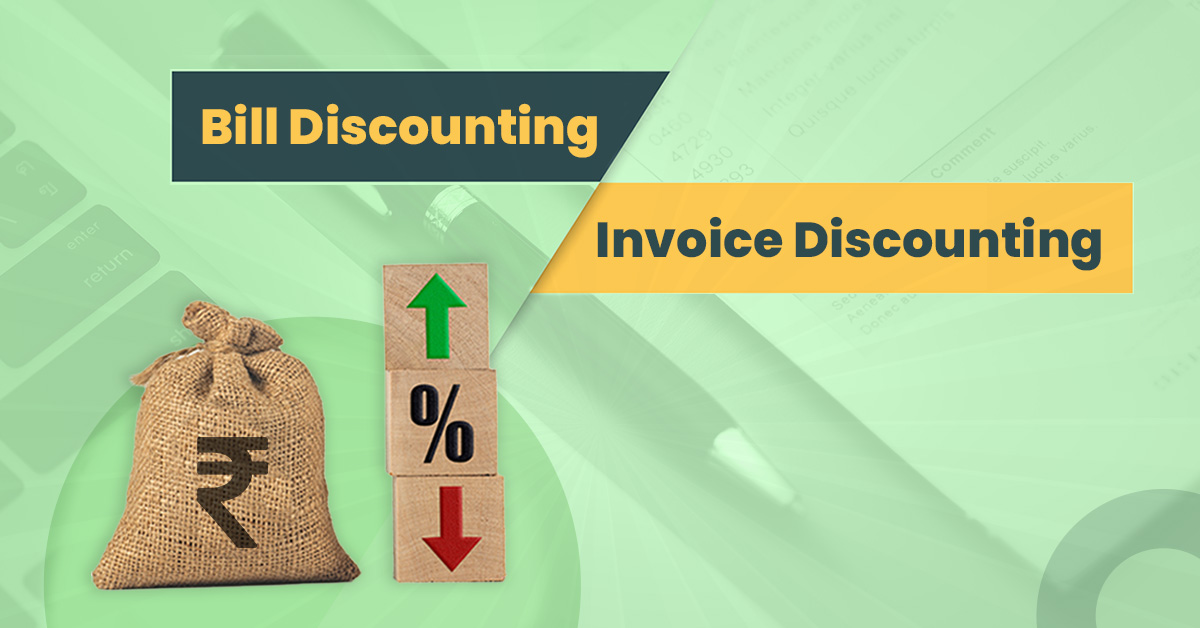What is the Difference Between Bill Discounting and Invoice Discounting?


One of the greatest fears of business owners in the world of small and medium-sized enterprises (SMEs) is a shortage of cash due to overdue payments from customers. In this case, the issue is not about whether or not these payments will be made but rather when they will be made. As a result of a delay in payment, a business owner may be unable to accept a new order.
Businesses often look at either bill discounting or invoice discounting as a solution to this problem because it is the quickest way to convert a future payment into cash. By providing a means for small and medium-sized enterprises to borrow money against future invoices or bills, bill discounting ensures that businesses can continue to operate smoothly without affecting their daily operations.
Bill discounting and invoice discounting are both forms of financing that are used to advance money to companies against their accounts receivable (i.e., unpaid invoices). It is critical for companies of all sizes to have access to working capital, and these are two methods to successfully accomplish the same . It’s common to hear people use the terms interchangeably, but technically that’s not correct.
In the blog, we will explain the difference between bill and invoice discounting, two terms that are often used interchangeably.
What is Invoice Discounting?
When awaiting payment of invoices, small and medium-sized businesses can experience a strain on their resources as well as operations. Invoice discounting can help in these situations.
The value of an organisation’s sales ledger can be accessed quickly and easily through invoice discounting. To put it simply, when you send an invoice to a client or customer, the lender will pay a certain percentage of that invoice directly to your business.
Invoice discounting can also be viewed as a series of short-term loans to a business, with the invoices themselves serving as collateral. That implies the lender has confidence in your ability to collect on the debt and will advance the majority of the funds to you before your customer has paid.
A notable feature of invoice discounting is that your customers will stay unaware of you using a finance provider because invoice discounting is typically done in secret (hence the name ‘confidential invoice discounting’). This will ensure that you continue to handle all interactions with them directly. However, you will still be responsible for following up on unpaid invoices.
Process of Invoice Discounting
The interest costs associated with invoice discounting are best handled by businesses with larger profit margins. In addition, invoice discounting can help both established and up-and-coming businesses. Here is how it goes down in detail:
- Step 1: Start by meeting customer needs by delivering desired goods and services. Provide your clients with an invoice, detailing the transaction’s date, due amount and the relevant contact information for both you and the client. Use invoice discounting if a client refuses to pay.
- Step 2: To avail invoice discounting, you should submit the invoices to your lender or financial provider. Remittance information can be found in the invoice itself. The invoice details are checked by the lender.
- Step 3: Invoice value is used to determine the loan amount. Businesses, invoice totals, and financing companies all affect the interest rate and time it takes to receive funds.
- Step 4: In some cases, your service provider or lender may handle the billing and payment process on your behalf. The alternative is that you’ll have to be the one to collect it. Collect any outstanding invoice debt by following the appropriate collection steps.
- Step 5: Your lender will reimburse you for the remaining balance on your invoice once payment has been received from the borrower. Remember that your lender will likely charge you interest and a service fee.
What is Bill Discounting?
Bill discounting is a method of obtaining immediate funds by borrowing against receivables that are scheduled to be paid in the future. In addition, the vendor receives prepayment from the middlemen in several transactions.
Simply put, bill discounting is the practice of selling an unpaid bill in advance to a third party (an invoice discounting company). The company assesses the creditworthiness and authenticity of both the parties concerned with the invoice. Based on this assessment, the interest and charges are decided.
In this scenario, the original invoice owner continues to pursue payment in the usual fashion.
Also Read: What Is GPF- General Provident Fund
Process of Bill Discounting
Below is a thorough explanation of how the bill discounting procedure works:
- The seller sells the products on credit and generates the buyer’s invoice.
- The invoice is accepted by the buyer. By approving, the buyer agrees to pay on the due date.
- The seller contacts the lending firm to negotiate a discount.
- The financial institution verifies the authenticity of the bill and the creditworthiness of the buyer.
- The financial institution makes the funds available to the seller after deducting the required margin, discount, and fee.
- The seller receives the funds and employs them for future transactions.
- The financial institution or the seller collects payment from the buyer on the due date. The agreement between the seller and the financial institution determines who will collect the funds.
Differences Between Bill Discounting and Invoice Discounting
Invoice discounting is similar to bill discounting in terms that it helps businesses get access to money. Businesses can finally collect the money they’ve been waiting for after sending out invoices, using any of these methods.
Both of these financing choices have their advantages and disadvantages. Bill discounting is similar to a bill of exchange, while invoice discounting is more like a loan. Bill discounting gives you greater leeway and can be used for bills. That is anywhere from 30 to 120 days overdue, whereas invoice discounting is limited to unpaid invoices that will be paid within 90 days.
No matter what financing option a business decides to pursue, they should be careful to compare rates and fees from several lenders. This is a significant factor that can reduce companies’ costs.
The size of your company is a major factor in deciding between bill discounting and invoice discounting. Your sales ledger capital requirements will also play a role.
Conclusion
To conclude, bill discounting is an acceptable means by which a business can satisfy its short-term funding needs. In contrast, companies with large profit margins are ideal for invoice discounting. Because they have the financial capability to bear the increased interest costs, this is especially typical among fast-growing, high-profit companies. And they rely on their steady cash flow to sustain their expansion.
FAQs
What is the distinction between bill discounting and purchase?
Similar to a loan, bills can be discounted to get a lower interest rate. The lender will advance a percentage of the unpaid invoices. And the repayment will occur whenever the company obtains payment from the consumer. Whereas in a bill purchase, the corporation makes a one-time payment to the financial institution.
What is bill discounting?
Bill discounting involves the sale of an organisation’s unpaid invoices for goods and services to a financial institution in anticipation of payment at a later date.
What is the difference between invoice factoring and invoice discounting?
In Invoice factoring, the client makes payment directly to the factoring company. On the other hand, invoice discounting entails payment from the business to the factoring company. Further, in invoice factoring, the financing company is responsible for collecting invoices. Whereas in invoice discounting, the business has to collect the invoices.
Is bill discounting the same as bills of exchange?
Bill discounting is similar to a loan where the lender provides a proportion of the unpaid invoices. This is repaid when the business receives payment from the consumer. As opposed to this, a bill of exchange is a legally binding written order used largely in international trade. That requires one party to pay another party a specified sum of money, either immediately or at a subsequent date.




